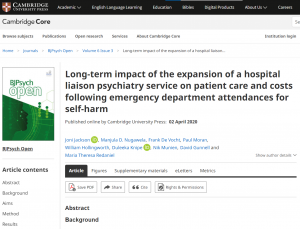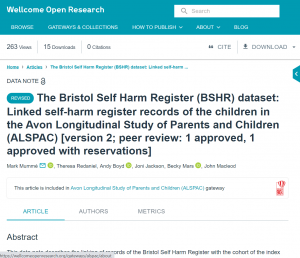Understanding self-harm using Bristol Self-Harm Surveillance Register data
Self-harm accounts for around 200,000 Emergency Department (ED) attendances annually in England. A quarter of these patients go on to self-harm again in the next year.
It is a major risk factor for suicide. A fifth of all people who die by suicide will have attended their local ED following self-harm sometime during the year before their death. More than a third have a history of self-harm. Their time in hospital is a valuable opportunity to prevent suicide.
The Register has been used to record detailed information on patients presenting to hospital for self-harm since September 2010. It is a database in the Emergency Department at the Bristol Royal Infirmary, part of University Hospitals Bristol NHS Foundation Trust.
The register shows how often people present at the hospital following self-harm. It also shows trends in the incidence of self-harm and how it’s managed. Hospital staff can use it to see the impact of changes in service delivery on patient management and outcomes. It also highlights risk factors for repeat self-harm and suicide and the medicines people use when they take an overdose.
This information is vital to local prevention efforts and to the Bristol Health Partners Improving Care in Self-Harm Health Integration Team (STITCH HIT). It provides an insight into the management of patients for clinicians and managers while also allowing the evaluation of services against NICE guidelines for treatment of self-harm patients.
Project aims
We analysed the Bristol Self-Harm Surveillance Register data to shed light on the types of people who are self-harming and trends in self-harm in the population served by the Bristol Royal Infirmary and Southmead Hospital. This work supports Bristol’s hospital psychiatry services and the Suicide Prevention Group led by Bristol City Council.
What we found and what this means
Over the three years after service expansion, the mean number of self-harm attendances increased 13%.
Median waiting time from arrival to psychosocial assessment was two hours shorter (18.6% decrease), there were 45 more referrals to other agencies (86.1% increase) and a small increase in the number of psychosocial assessments (11.7% increase) per month.
Monthly mean net hospital costs were £34 more per episode (5.3% increase).
Papers

Long-term impact of the expansion of a hospital liaison psychiatry service on patient care and costs following emergency department attendances for self-harm
Read the paper
The Bristol Self Harm Register (BSHR) dataset: Linked self-harm register records of the children in the Avon Longitudinal Study of Parents and Children (ALSPAC)
Read the paperLead collaborators
- David Gunnell, University of Bristol

